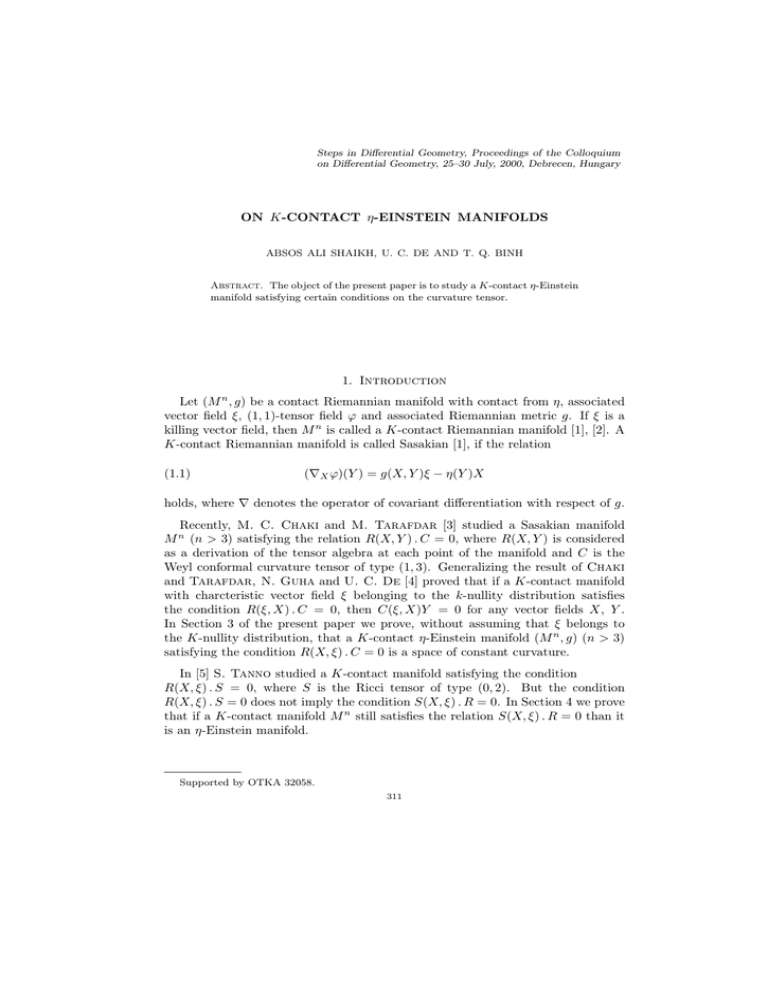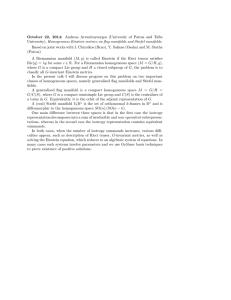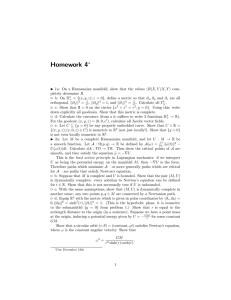Steps in Differential Geometry, Proceedings of the Colloquium
advertisement

Steps in Differential Geometry, Proceedings of the Colloquium on Differential Geometry, 25–30 July, 2000, Debrecen, Hungary ON K-CONTACT η-EINSTEIN MANIFOLDS ABSOS ALI SHAIKH, U. C. DE AND T. Q. BINH Abstract. The object of the present paper is to study a K-contact η-Einstein manifold satisfying certain conditions on the curvature tensor. 1. Introduction n Let (M , g) be a contact Riemannian manifold with contact from η, associated vector field ξ, (1, 1)-tensor field ϕ and associated Riemannian metric g. If ξ is a killing vector field, then M n is called a K-contact Riemannian manifold [1], [2]. A K-contact Riemannian manifold is called Sasakian [1], if the relation (1.1) (∇X ϕ)(Y ) = g(X, Y )ξ − η(Y )X holds, where ∇ denotes the operator of covariant differentiation with respect of g. Recently, M. C. Chaki and M. Tarafdar [3] studied a Sasakian manifold M n (n > 3) satisfying the relation R(X, Y ) . C = 0, where R(X, Y ) is considered as a derivation of the tensor algebra at each point of the manifold and C is the Weyl conformal curvature tensor of type (1, 3). Generalizing the result of Chaki and Tarafdar, N. Guha and U. C. De [4] proved that if a K-contact manifold with charcteristic vector field ξ belonging to the k-nullity distribution satisfies the condition R(ξ, X) . C = 0, then C(ξ, X)Y = 0 for any vector fields X, Y . In Section 3 of the present paper we prove, without assuming that ξ belongs to the K-nullity distribution, that a K-contact η-Einstein manifold (M n , g) (n > 3) satisfying the condition R(X, ξ) . C = 0 is a space of constant curvature. In [5] S. Tanno studied a K-contact manifold satisfying the condition R(X, ξ) . S = 0, where S is the Ricci tensor of type (0, 2). But the condition R(X, ξ) . S = 0 does not imply the condition S(X, ξ) . R = 0. In Section 4 we prove that if a K-contact manifold M n still satisfies the relation S(X, ξ) . R = 0 than it is an η-Einstein manifold. Supported by OTKA 32058. 311 312 ABSOS ALI SHAIKH, U. C. DE AND T. Q. BINH 2. Preliminaries In a K-contact Riemannian manifold the following relations hold: [1], [2], [6] (2.1) a) ϕξ = 0, g(ϕX, ϕY ) = g(X, Y ) − η(X)η(Y ) ∇X ξ = −ϕX (2.4) (2.5) g(R(ξ, X)Y ), ξ) = η(R(ξ, X)Y ) = g(X, Y ) − η(X)η(Y ) (2.6) R(ξ, X)ξ = −X + η(X)ξ (2.7) S(X, ξ) = (n − 1)η(X) (2.8) c) g(X, ξ) = η(X) ϕ X = −X + η(X)ξ (2.2) (2.3) b) η(ξ) = 1 2 (∇X ϕ)(Y ) = R(ξ, X)Y for any vector fields X, Y . A K-contact manifold M n is said to be η-Einstein if its Ricci tensor S is of the form S = ag + bη ⊗ η, where a, b are smooth functions on M . 3. K-contact η-Einstein manifolds satisfying R(X, ξ) . C = 0 Let us consider a K-contact η-Einstein manifold M n (n > 3) satisfying the relation (3.1) R(X, ξ) . C = 0. In this case we have (3.2) S(X, Y ) = ag(X, Y ) + bη(X)η(Y ). Putting X = Y = ξ in (3.2) and then using (2.7) and (2.1) b, we get n − 1 = a + b. (3.3) Also (3.2) implies that (3.4) r = an + b. From (3.3) and (3.4) we have (3.5) a= r − 1, n−1 b=n− r . n−1 Again from (3.2) we obtain r r (3.6) QX = −1 X + n− η(X)ξ, n−1 n−1 where Q denotes the Ricci operator, i.e. g(QX, Y ) = S(X, Y ). ON K-CONTACT η-EINSTEIN MANIFOLDS By definition the Weyl conformal curvature tensor C is given by 1 (3.7) C(X, Y )Z = R(X, Y )Z − g(Y, Z)QX − g(X, Z)QY n−2 + S(Y, Z)X − S(X, Z)Y r + g(Y, Z)X − g(X, Z)Y . (n − 1)(n − 2) Using (3.2) and (3.6) in (3.7), we get 2 r (3.8) C(X, Y )Z = R(X, Y )Z + − g(Y, Z)X−g(X, Z)Y (n−1) (n−2) r n − g(Y, Z)η(X)ξ−g(X, Z)η(Y )ξ − n−1 (n−1)(n−2) + η(Y )η(Z)X − η(X)η(Z)Y . Now (3.1) gives us by definition (3.9) R(X, ξ)C(U, V )W − C(R(X, ξ)U, V )W − C(U, R(X, ξ)V )W −C(U, V )R(X, ξ)W = 0, for all X, U, V, W. Substitution of U and W by ξ in (3.9) yields (3.10) R(X, ξ)C(ξ, V )ξ − C(R(X, ξ)ξ, V )ξ − C(ξ, R(X, ξ)V )ξ −C(ξ, V )R(X, ξ)ξ = 0. From (3.8) we get by virtue of (2.1) (b), (2.1) (c) and (2.6), (3.11) C(ξ, V )ξ = 0, for any vector field V. Hence by virtue of (3.11) we have (3.12) R(X, ξ)C(ξ, V )ξ = 0. Again in view of (2.6) we get C(R(X, ξ)ξ, V )ξ = C(X, V )ξ − η(X)C(ξ, V )ξ which implies by means of (3.11) that (3.13) C(R(X, ξ)ξ, V ) = C(X, V )ξ. From (3.8) we obtain (3.14) C(X, V )ξ = R(X, V )ξ − η(V )X + η(X)V for any vector fields X and V . By virtue of (3.13) and (3.14) we have (3.15) C(R(X, ξ)ξ, V )ξ = R(X, V )ξ − η(V )X + η(X)V, and by virtue of (3.11) we get (3.16) C(ξ, R(X, ξ)V )ξ = 0. Finally using (2.6), we have C(ξ, V )R(X, ξ)ξ = C(ξ, V )X − η(X)C(ξ, V )ξ, 313 314 ABSOS ALI SHAIKH, U. C. DE AND T. Q. BINH from which it follows by means of (3.11) and (3.14) that (3.17) C(ξ, V )R(X, ξ)ξ = R(ξ, V )X − g(X, V )ξ + η(X)V. Applying (3.12), (3.15), (3.16) and (3.17) in (3.10) we obtain (3.18) R(X, V )ξ + R(ξ, V )X − g(X, V )ξ − η(V )X + 2η(X)V = 0. Interchanging X and V in (3.18) we have (3.19) R(V, X)ξ + R(ξ, X)V − g(X, V )ξ − η(X)V + 2η(V )X = 0. Subtracting (3.19) from (3.18) and then using Bianchi’s first identity, we get R(X, V )ξ = η(V )X − η(X)V, from which it follows that (3.20) R(ξ, X)Y = g(X, Y )ξ − η(Y )X. In view of (1.1), (2.8) and (3.20), we obtain that the manifold is Sasakian and hence by the result of Chaki and Tarafdar [3], the manifold is a space of constant curvature 1. Thus we have the following Theorem 1. A K-contact η-Einstein manifold (M n , g) (n > 3) satisfying the condition R(X, ξ) . C = 0 is a space of constant curvature 1. A contact Riemannian manifold satisfying the condition R(X, ξ) . C = 0 have been studied by C. Baikoussis and T. Koufogiorgos [7]. 4. K-contact manifolds satisfying the condition S(X, ξ) . R = 0 We consider a K-contact Riemannian manifold M n satisfying the condition (4.1) (S(X, ξ) . R(U, V )W = 0. Now by definition we have (S(X, . ξ) . R(U, V )W = ((X ∧s ξ) . R)(U, V )W = (X ∧s ξ)R(U, V )W (4.2) + R((X, ∧S ξ)U, V )W + R((U, (X ∧s ξ)V )W + R(U, V )(X ∧s ξ)W, where the endomorphism X ∧s Y is defined by (4.3) (X ∧s y)Z = S(Y, Z)X − S(X, Z)Y. Using the definition of (4.3) in (4.2), we get by virtue of (2.7) S(X, ξ) . R(U, V )W = (n − 1) η(R(U, V )W )X + η(U )R(X, V )W + η(V )R(U, X)W + η(W )R(U, V )X (4.4) − S(X, R(U, V )W )ξ − S(X, U )R(ξ, V )W − S(X, V )R(U, ξ)W − S(X, W )R(U, V )ξ ON K-CONTACT η-EINSTEIN MANIFOLDS 315 and by virtue of (4.1) and (4.4) we have (n − 1) η(R(U, V )W )X + η(U )R(X, V )W + η(V )R(U, X)W (4.5) +η(W )R(U, V )W ) − S(X, R(U, V )W )ξ − S(X, U )R(ξ, V )W −S(X, V )R(U, ξ)W − S(X, W )R(U, V )ξ = 0. Taking the inner product on both sides of (4.5) by ξ, we obtain (n − 1) η(R(U, V )W )η(X) + η(U )η(R(X, V )W + η(V )η(R(U, X)W ) + η(W )η(R(U, V )X) (4.6) − S(X, R(U, V )W ) − S(X, U )η(R(ξ, V )W ) − S(X, V )η(R(U, ξ)W ) − S(X, W )η(R(U, V )ξ) = 0. Putting U = W = ξ in (4.6) and using (2.5)–(2.7) we get S(X, V ) = −(n − 1)g(X, V ) + 2(n − 1)η(X)η(V ) which means that the manifold is η-Einstein. Thus we have the following Theorem 2. A K-contact Riemannian manifold (M n , g) satisfying the condition S(X, ξ) . R = 0 is an η-Einstein manifold. From Theorem 1 and Theorem 2 we immediately have: Theorem 3. A K-contact Riemannians manifold (M n , g) stisfying the conditions S(X, ξ)R = 0 and R(X, ξ)C = 0 is a space of constant curvature 1. References [1] D. E. Blair, Contact manifolds in Riemannian geometry, Lecture Notes in Mathematics, 509, Springer-Verlag, Berlin, 1976 [2] S. Sasaki, Lecture note on almost contact manifolds, Part-I, Tohoku University, 1965 [3] M. C. Chaki and M. Tarafdar, On a type of Sasakian manifold, Soochow J. of Math., 16 1990, 23-28. [4] N. Guha and U. C. De, On K-contact manifolds, Serdica-Bulgaricae Math. Publ., 19, 1993, 267-272. [5] S. Tanno, Isometric immersions of Sasakian manifolds in spheres, Kodai Math. Sem. Rep., 21, 1969, 448–458. [6] S. Sasaki, Lecture note on almost contact manifolds, Part-II, Tohoku University, 1967 [7] C. Baikoussis and T. Koufogiorgos, On a type of contact manifolds, J. of Geom., 46, 1993, 1-8. Absos Ali Shaikhand and U. C. De, Department of Mathematics, University of Kalyani, Kalyani-741235, W.B., India T. Q. Binh, Institute of Mathematics, and Informatics, Debrecen University, H-4010 Debrecen, P.O. Box 12, Hungary E-mail address: binh@math.klte.hu




